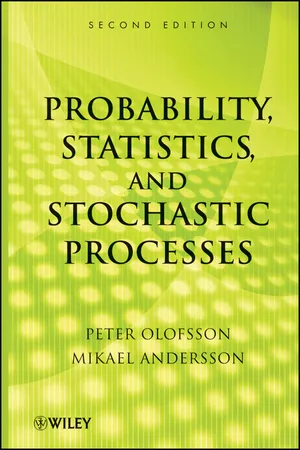
Probability, Statistics, and Stochastic Processes
Peter Olofsson, Mikael Andersson
- English
- ePUB (apto para móviles)
- Disponible en iOS y Android
Probability, Statistics, and Stochastic Processes
Peter Olofsson, Mikael Andersson
Información del libro
Praise for the First Edition
"... an excellent textbook... well organized and neatly written."
— Mathematical Reviews
"... amazingly interesting..."
— Technometrics
Thoroughly updated to showcase the interrelationships between probability, statistics, and stochastic processes, Probability, Statistics, and Stochastic Processes, Second Edition prepares readers to collect, analyze, and characterize data in their chosen fields.
Beginning with three chapters that develop probability theory and introduce the axioms of probability, random variables, and joint distributions, the book goes on to present limit theorems and simulation. The authors combine a rigorous, calculus-based development of theory with an intuitive approach that appeals to readers' sense of reason and logic. Including more than 400 examples that help illustrate concepts and theory, the Second Edition features new material on statistical inference and a wealth of newly added topics, including:
-
Consistency of point estimators
-
Large sample theory
-
Bootstrap simulation
-
Multiple hypothesis testing
-
Fisher's exact test and Kolmogorov-Smirnov test
-
Martingales, renewal processes, and Brownian motion
-
One-way analysis of variance and the general linear model
Extensively class-tested to ensure an accessible presentation, Probability, Statistics, and Stochastic Processes, Second Edition is an excellent book for courses on probability and statistics at the upper-undergraduate level. The book is also an ideal resource for scientists and engineers in the fields of statistics, mathematics, industrial management, and engineering.
Preguntas frecuentes
Información
1.1 Introduction


